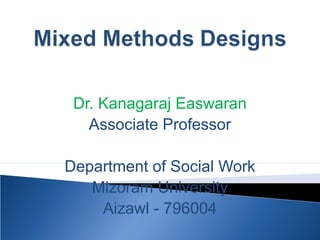
02 mixed methods designs
- 1. Dr. Kanagaraj Easwaran Associate Professor Department of Social Work Mizoram University Aizawl - 796004
- 2. Aspect Quantitative Qualitative Data Numbers Words Point of View Researcher Participants Relationship: Researcher and Researched Distance Close Role of Theory Testing Emerging Design Static Process- Emergent
- 3. Aspect Quantitative Qualitative Questions Structure Unstructured Outcome Generalisation Contextual Understanding Nature of Data Hard, Reliable Data Rich, deep data Level Macro Micro Focus of Research Behaviour Meaning Setting Artificial Natural
- 4. Hardy and Bryman (2004) Data Reduction: Answering research questions: Concerned with relating Results to literature: Concerned with variation: Frequency as a springboard for analysis
- 5. Hardy and Bryman (2004) Deliberate distortion not to occur: Importance of Transparency: Address the question of error: Research methods appropriate to research questions:
- 6. Employing Combination of quantitative and qualitative methods Perceived legitimacy of both methods Multi method, convergence, integrated, and combined Data derived from mixed methods - mutually illuminating not use of them in tandem
- 7. Campbell and Fisk(1959) used multi methods - validity of psychological traits Encouraged others to employ multi method Started mix methods: qualitative data (field methods viz., observation, interview combined with quantitative data(traditional surveys) (Sieber 1973)
- 8. Recognition: All methods have limitations – biases inherent in single method could neutralise or cancel the biases of other methods. Triangulating data sources – a means for seeking convergence across qual quan methods (Jick 1979). By early 1990s movement from convergence to integrating and connecting(Takhakkori and Teddlie 1998).
- 9. Research methodology evolves and develops continuously Step forward utilizing strengths of both Inadequacy of application of quantitative or qualitative methods alone to complexity of social or human phenomena
- 10. Interdisciplinary nature of research – research teams with diverse methodological orientations Expanded understanding greater insight from combination
- 11. Embedded Method Argument : Research methods rooted in epistemological and ontological commitments Methods not mere data gathering procedures but commitment Mixed methods not feasible or even desirable. Ignores underlying assumptions and transforms of qualitative inquiry into a procedural variation of quantitative inquiry(Smith and Heshusius(1986). Research Methods do not carry with them fixed epistemological and ontological implications – capable of used in a variety of ways.
- 12. Quantitative vs Qualitative Paradigms: ◦ Two incompatible world views – incommensurable ◦ Integration superficial level and within a single paradigm
- 13. Contentions about interconnections between methods and paradigms cannot be demonstrated. ◦ No means clear that quantitative and qualitative approaches are paradigms. ◦ There are overlaps and commonality between them
- 14. Epistemological Version: Incompatible Mixed Methods is not possible Technical Version: Strengths of both and capable of mixing Distinctive epistemological ontological assumptions recognised Connection between assumptions and methods not viewed as fixed and ineluctable. Methods are autonomous and hence compatible, feasible and desirable
- 15. Alan Bryman (2006) Purposes or ways 1. Triangulation or Grater Validity: Mutual corroboration 2. Offset: Research methods have own strengths and weaknesses – combining offsets – draw strengths of both. 3. Completeness: more comprehensive account 4. Process: Quan: Structure – Qual : Process Dynamics 5. Different Research Questions : Different methods
- 16. 6. Explanation: one methods results are interpreted with the help of the other 7. Unexpected Results: Surprising results of one are explained by the other 8. Instrument Development: Development of Questionnaire or Scale – identify close ended answers. 9. Sampling: one approach is used to facilitate sampling of respondents or cases.
- 17. 10. Credibility: both together enhance integrity of findings 11. Context: qualitative research providing contextual understanding coupled with externally valid findings of survey 12. Illustration: qualitative data to illustrate the findings of quantitative research: putting meat on the bones of dry quantitative findings. 13. Utility or Improving the Usefulness of Findings: combination is more useful to practitioners
- 18. 14. Confirm or Discover: qualitative data to generate hypotheses and quantitative to test that 15. Diversity of Views: Combining researcher’s and participants views – uncovering relationships and revealing meanings among participants. 16. Enhancement or Building upon Quantitative/Qualitative Findings: Making more of or augmenting either quantitative or qualitative findings by gathering data
- 19. Aspect Quantitative Mixed Qualitative Methods/ Design Predetermined Both Emerging Questions Closed Both Open ended Type of Data Performance, Attitude , Observational Multiple forms from all possibilities Interview Observation Documents, Audio Visual Analysis Statistical Both Text and Image Interpretation Statistical Across databases interpretati on Themes, Patterns Interpretation
- 20. Timing Weighting Mixing Theorizing Concurrent No Sequence Equal Integrating Explicit Sequential : Qualitative First Qualitative Connecting ImplicitSequential: Quantitative First Quantitative Embedding
- 21. Quan Qual data are merged on one end of the continuum, kept separate on the other end Combined some way between these two extremes Connecting: Quan Qual methods are connected: First phase data collection, analysis second phase data collection. Integrating Data collected concurrently - the two data bases are merged Embedding: One form of data main source – other supportive
- 22. Whether a larger, theoretical perspective guides the entire design. Social Science theory or broad theoretical lens(gender, race, class etc.) Explicitly mentioned or implicitly not mentioned Explicit lens shapes questions and guides research process and drawing implications
- 23. Creswell et al. 1. Sequential Designs: One after another 2. Concurrent Designs: Together Simultaneously
- 24. 1. Sequential Explanatory Design 2. Sequential Exploratory Design 3. Sequential Transformative Design 1. Qual – quan 2. Quan - qual
- 25. 1. Concurrent Triangulation Design 1. Data Results are compared 2. Equal Weight to both 2. Concurrent Embedded Design 1. One takes primary and another supportive 3. Concurrent Transformative Design 1. Emancipatory theory as lens 2. QUAN + QUAL or 3. qual + QUAN
- 27. Thanks
